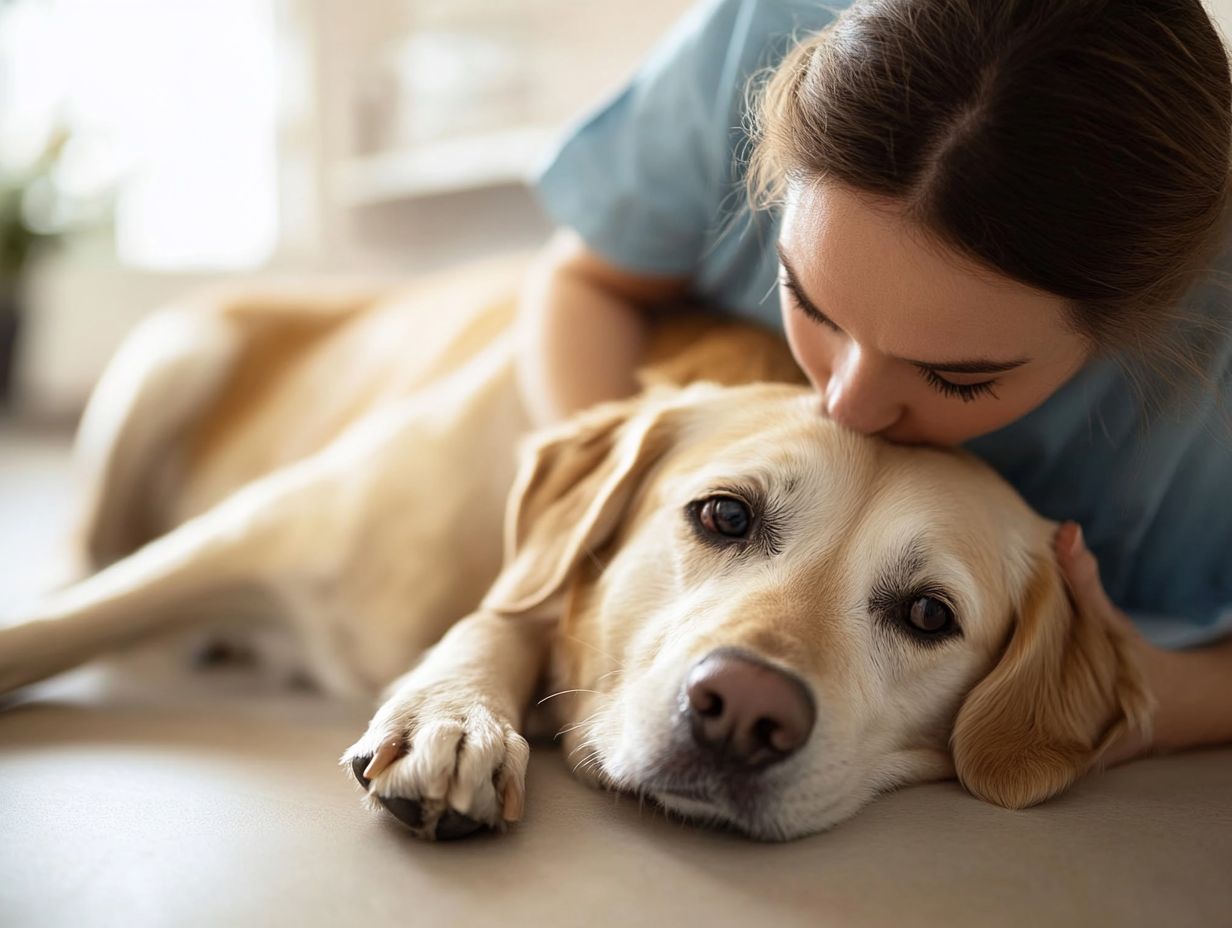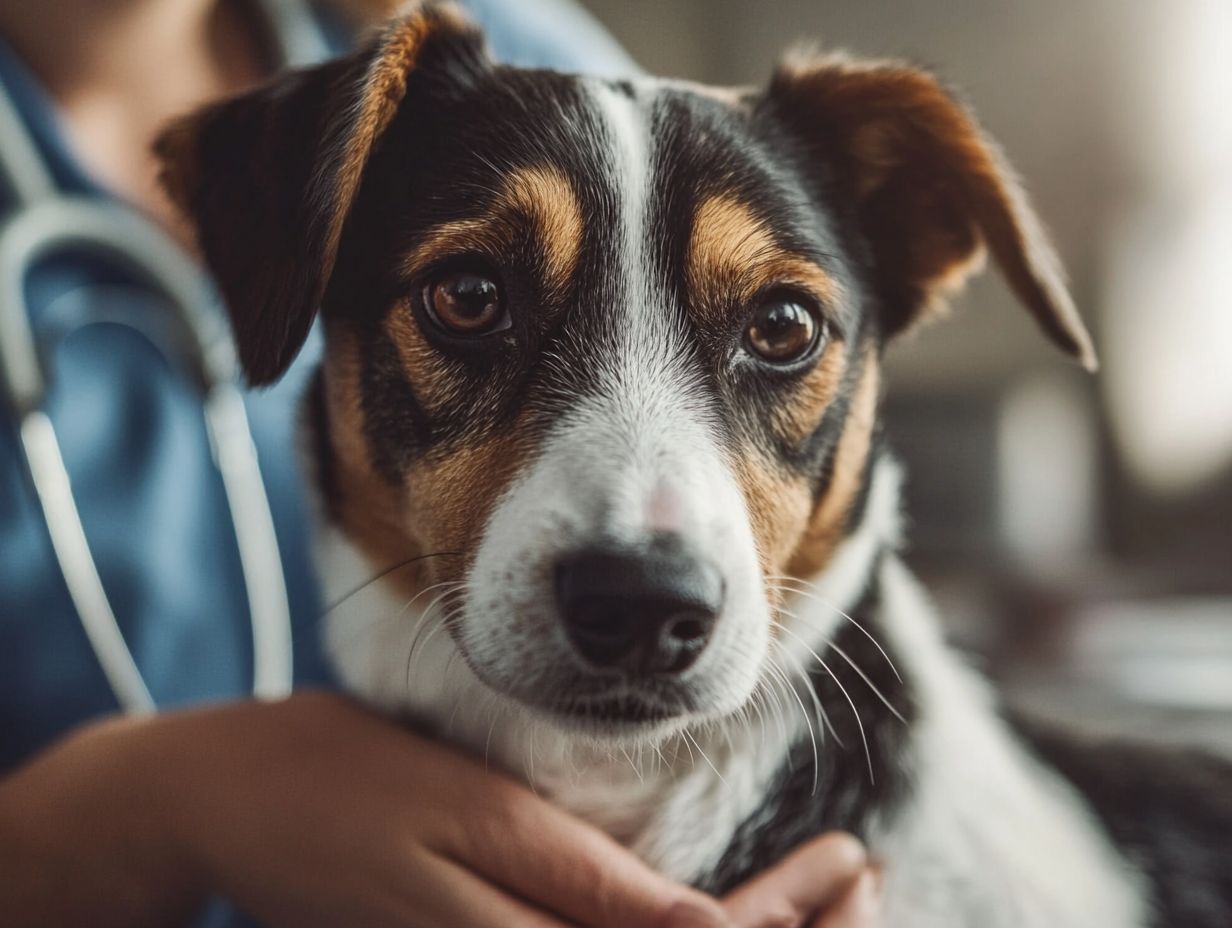What to Expect During a Pet Anxiety Assessment
Dog anxiety is a common concern that impacts many pets, leading to distress and behavioral issues, especially in cases of separation anxiety and other disorders.
As a pet owner, understanding the causes and symptoms is vital. This guide highlights the importance of conducting a pet anxiety assessment and outlines the assessment process, along with the tools and resources referenced in the veterinary manual.
You will learn how to interpret the results and explore treatment options, including anxiety medications and CBD oil, allowing you to help your furry friend enjoy a happier, more relaxed life.
Contents
- Key Takeaways:
- Pet Anxiety: Understanding the Condition
- The Importance of a Pet Anxiety Assessment
- The Assessment Process
- Tools and Resources Used in the Assessment
- Interpreting the Results
- Treatment Options for Pet Anxiety
- Frequently Asked Questions
- What is a pet anxiety assessment, including separation anxiety?
- How long does a pet anxiety assessment take?
- What happens during a pet anxiety assessment?
- Do I need to prepare anything for a pet anxiety assessment?
- Can I be present during my pet’s anxiety assessment?
- What should I expect after a pet anxiety assessment, particularly regarding the treatment plan?
Key Takeaways:

- Pet anxiety can show up in various behaviors like excessive barking and aggression. Understanding the common causes and symptoms is crucial.
- A pet anxiety assessment is essential for your pet’s well-being, as it helps identify the root cause of their anxiety for effective treatment.
- The assessment process includes examining your pet’s behavior, medical history, and environmental factors. Techniques like behavior observation and questionnaires are commonly used.
Pet Anxiety: Understanding the Condition
Pet anxiety is a complex issue that many dogs face, manifesting as separation anxiety, fear-related anxiety, or behavioral challenges. These issues can significantly affect the quality of life for both your pet and you as the owner, especially for senior dogs experiencing a decline in mental abilities.
To truly understand this condition, it s important to explore its common causes and symptoms and potential treatment plans. Referencing authoritative sources like the AKC and Merck Veterinary Manual can guide you in addressing and alleviating your dog’s anxiety.
Causes and Symptoms
Recognizing the causes and symptoms of dog anxiety is key to helping anxious pets and creating effective strategies to alleviate their distress. Many environmental factors, such as loud noises and changes in routine, can contribute to this condition.
Past trauma from neglect or abuse can also leave lasting effects, causing heightened anxiety responses. Symptoms can appear as excessive barking, destructive behavior, or shifts in appetite.
Senior dogs may be particularly susceptible to cognitive dysfunction, which can worsen anxiety as they age, resulting in confusion and distress. By recognizing these signs, you can provide the necessary support and create a comfortable environment for your furry companions.
The Importance of a Pet Anxiety Assessment
Conducting a thorough pet anxiety assessment is crucial for creating an effective treatment plan that addresses the unique needs of anxious dogs. This safeguards their well-being and provides peace of mind for their owners, especially in a veterinary clinic.
Why It’s Necessary for Your Pet’s Well-Being
Assessing your pet’s anxiety is a vital step in addressing their behavioral issues. This process can enhance their overall well-being, particularly for those dealing with anxiety disorders or older pets.
By identifying the underlying causes of their stress, you can create personalized treatment plans that effectively target specific behavioral concerns. This fosters a more harmonious home environment.
A thorough evaluation uplifts your furry friend s emotional health, boosting their confidence and easing their fears. It also reduces the stress you may feel as a pet owner.
When your pets feel secure, they’re less likely to show destructive behaviors or heightened reactivity, leading to a peaceful home that nurtures healthier interactions.
This assessment paves the way for an improved quality of life, ensuring that you and your pet can enjoy a fulfilling and joyful companionship.
Take the first step for your pet today contact your vet for an assessment!
The Assessment Process

The assessment process for pet anxiety requires a meticulous approach. It incorporates comprehensive behavioral evaluations and potential consultations at a veterinary clinic. This method offers you essential insights into your dog’s anxiety disorder and equips you with effective treatment plans tailored to their specific needs.
Steps and Techniques Used
The steps and techniques involved in pet anxiety assessments are crucial. Techniques like counterconditioning (changing your pet’s emotional response to a trigger) and desensitization (gradually exposing your dog to anxiety-inducing situations) are essential for effectively addressing behavioral challenges and enhancing communication with your anxious dog.
These methods gradually introduce your dog to anxiety triggers while pairing them with positive experiences. By conducting thorough behavioral evaluations, you’ll gain insights into your dog’s unique reactions to various situations. This enables you to develop more tailored and effective strategies.
Employing communication techniques, such as observing body language and adjusting your vocal tone, deepens the bond between you and your pet. This fosters a clearer understanding of your dog’s emotional state.
Ultimately, this holistic approach not only alleviates anxiety but also strengthens your relationship through mutual trust and understanding.
Tools and Resources Used in the Assessment
You have access to a range of tools and resources to assess pet anxiety. This includes valuable insights from the veterinary manual.
This guide helps you understand behavioral issues and enables you to craft effective treatment plans for anxious dogs.
Types of Assessments and Their Purpose
Various types of assessments tackle the multifaceted nature of anxiety disorders in dogs. Each one serves a distinct purpose, playing a crucial role in crafting comprehensive treatment plans and effective training strategies.
These assessments include behavioral evaluations, observational checklists, and standardized tests. They help you identify specific triggers and patterns of anxiety.
By closely analyzing your dog s responses in different environments and situations, you can uncover what intensifies their condition and contributes to their anxiety. For instance, a behavioral assessment might reveal that your dog becomes anxious around loud noises but remains calm in familiar settings.
This knowledge helps you create better interventions, such as desensitization techniques or environmental adjustments, ensuring that your dog’s unique needs are effectively addressed. Ultimately, grasping these nuances significantly enhances the efficacy of treatment programs, paving the way for more successful management of canine anxiety.
Interpreting the Results
Interpreting the results of pet anxiety assessments is essential. It gives you the power to understand your dog’s unique anxiety challenges. This understanding forms the foundation for a treatment plan meticulously tailored to their specific needs.
What the Results Mean for Your Pet

The results of a pet anxiety assessment offer valuable insights into your dog’s condition. They reveal crucial information that influences treatment options and aids in understanding your pet’s behavioral challenges.
These findings often pinpoint specific triggers contributing to your canine’s stress, such as loud noises, shifts in routine, or separation anxiety. By grasping these factors, you can make informed decisions about behavioral therapies, enriching their environment, or even considering medication when necessary.
Recognizing the severity of the anxiety guides you in implementing gradual desensitization techniques or establishing routines that foster a sense of security for your dog.
The overarching goal is to enhance your dog’s quality of life while alleviating the emotional burden on you. This ultimately creates a more harmonious living environment for both of you.
Start your journey today towards a calmer, happier dog!
Treatment Options for Pet Anxiety
You have access to a variety of treatment options for pet anxiety, including behavioral therapies, anxiety medications, and innovative solutions like CBD oil.
Each option is designed to address the unique needs of anxious dogs, ensuring that their treatment plans are both effective and personalized.
Therapies and Techniques to Help Your Pet
Therapies and techniques such as conditioning and gradual exposure are crucial for alleviating dog anxiety. These should be integral to your comprehensive treatment plan.
Conditioning is a method that helps change how your dog feels about certain situations. Gradual exposure reduces the fear associated with specific triggers, allowing your dog to relax over time.
Incorporating consistent obedience training helps reinforce positive behaviors and builds trust between you and your dog. This creates a supportive environment that enhances behavioral modification.
When implemented together, these strategies equip you with effective tools to elevate your dog s overall well-being, fostering a more harmonious home life.
Frequently Asked Questions
What is a pet anxiety assessment, including separation anxiety?
A pet anxiety assessment is a process conducted by a veterinarian or animal behaviorist to evaluate the level of anxiety and stress in a pet. This helps identify the underlying causes of anxiety and determine the best course of treatment.
How long does a pet anxiety assessment take?

The length of the assessment varies depending on the pet’s specific needs. On average, it can take anywhere from 30 minutes to an hour, but some assessments may take longer.
What happens during a pet anxiety assessment?
During the assessment, the veterinarian will observe the pet’s behavior, ask questions about their history and environment, and may conduct tests to evaluate anxiety levels. They may also discuss when to consult a professional for pet anxiety with you.
Do I need to prepare anything for a pet anxiety assessment?
It is helpful to have your pet’s medical records and any previous behavior assessments or treatments available for review. Bring your pet in a comfortable state, ensuring they are neither too hungry nor tired.
Can I be present during my pet’s anxiety assessment?
It is recommended that you be present during the assessment to provide valuable information. However, if your presence may affect your pet’s behavior, the veterinarian may ask you to step out for part of the assessment.
What should I expect after a pet anxiety assessment, particularly regarding the treatment plan?
After the assessment, the veterinarian will discuss their findings and recommend a treatment plan. This may include medication, behavior modification techniques, or a combination of both, addressing symptoms of anxiety and helping to prevent anxiety in the future.
You can make a difference in your pet s life today! Explore these effective treatment options now to give your furry friend the peace they deserve.






